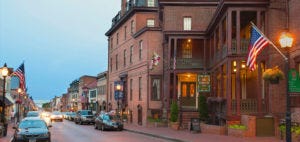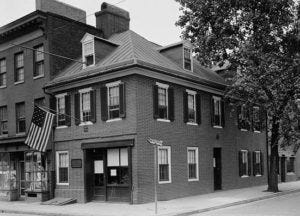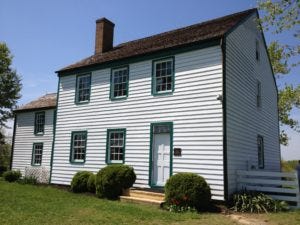Written By Malcolm Lawson
It doesn’t take much to fall in love with the historic homes throughout Maryland! Buyers are often pulled in by the architectural detail and character that only a historic home can offer. However, before purchasing a Maryland historic home, it is important to understand what a historic home is and what requirements come with it.
What is a Historic Home?
A “historical home” can mean different things to different people. Some people are just looking to enjoy the charm and character that an older house has to offer. Other people are looking for a house with historical significance.
For a home to be considered a historic home according to the National Register of Historic Places(NRHP) it needs to be at least 50 years old. Houses also must have some sort of historical significance to be listed as a historic home. The house could have been lived in by a significantly important person in history, been the location of a historical event or simply located in a historical neighborhood. The house also needs to resemble its original structure.
Many cities have historic districts. These are neighborhoods in the city that have buildings in it that are significant to that city’s history and making. They are specifically designated by either the state or the city and are then protected as such.

Why Buy a Maryland Historic Home
Many people are interested in owning a historic home simply to enjoy the charm and feel that it provides. Others like to feel that they are playing a part in history. There are many different reasons that people want to purchase one, but here are some advantages that they can offer:
- Amazing architectural detail
- Many areas offer low interest rates and/or tax advantages to those that are willing to renovate and care for historical homes
- A chance to connect with other history buffs in your area
- Many historical homes are able to serve functions such as hosting weddings or providing historical tours.
Limitation in Renovating a Historic Home In Maryland
At first consideration, it can seem like it would be fun to live in and care for a historic home, however, there can be many requirements and restrictions that come along with owning the property. It is important for you to research and understand exactly what they are before you decide to purchase and risk ending up over your head.
The restrictions that come along with a historic home will vary from neighborhood to neighborhood and city to city. They can include restrictions that limit you from changing the original footprint of the house, leaving it impossible to update into a more modern feel. The paint colors used on the exterior of the house can be restricted to the colors that are accurate for the period the house was built in. Some restrictions can make it difficult to make energy efficient upgrades to the house, as many places require keeping the original doors and windows intact.
Since you are acting as a caregiver to the home as well as the homeowner, typically the cost of maintaining the house and landscaping is higher than it would be if the home were not a historical home. There can be requirements on how the landscaping is kept and that outbuildings be repaired to their original condition. Here are some of the common disadvantages of purchasing a historic home:
- Possible issues with the structure
- Home might be in need of all new plumbing and electrical
- It could have lead paint, asbestos or mold
- Will possibly require the hiring of preservationist
- Restoring a historic home is more costly than remodeling a regular home
- The house could have many restrictions, rules, and guidelines for you to adhere to
Examples of Maryland Historic Homes

An example of a Maryland Historic Home would be the Flag House built in 1793 and located in downtown Baltimore. In 1806 Mary Pickersgill moved to this home and would later sew the Star Spangled Banner here. The flag that flew over Fort McHenry during the Battle of Baltimore in the War of 1812.
Another example would be St. Catharine also known as Dr.Mudd’s House located in Southern Maryland. It was in this home that Dr.Mudd treated the injuries of John Wilkes Booth after the assassination of Abraham Lincoln.

Available Programs for Purchasing a Maryland Historic Home
If you are interested in purchasing a Maryland historic home to help preserve a part of history, the Maryland Historic Trust has many available programs to assist you.
- Grants — The Maryland Historical Trust distributes several different grant programs to help preserve historically significant areas in the state. The different programs have their own deadlines, regulations, and applications. You can read more details on each program and check for availability here.
- Homeowner Tax Credit — There are opportunities for owners to receive a tax credit up to 20 percent of the qualified rehabilitation expenditures performed up to $50,000 in a two year period. There are requirements for which properties apply for the credit as well as what rehabilitation expenses can be covered. Details of the credit can be found here.
- Loans — There are loans available through the Maryland Historical Trust Historic Preservation Loan Program to help preserve historic sites throughout the state. There are strict guidelines on what properties qualify and who is eligible to obtain this financing. More details can be found on the website here
Still Interested?
Does the thought of owning a Maryland historic homes still sound appealing to you? Start looking for a house that piques your interest. Take the time to do your due diligence before purchasing. Make sure that you have a thorough home inspection completed so you understand what work will need to be done. Speak to several contractors to find out estimates of how much the renovations would cost to complete. Find out what restrictions and requirements are on the house due to its historical significance. Work with professionals that are experienced in working on historic homes. And, most importantly, learn the historical significance of the property and allow it to be a part of all you do in preserving and caring for the property.




